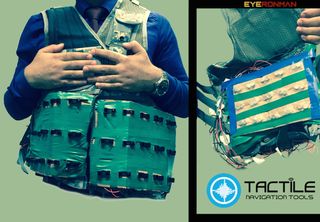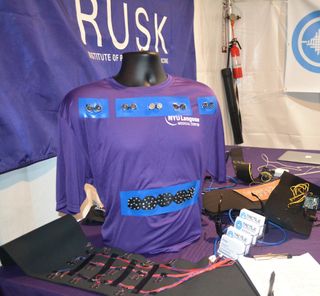Seeing-Eye Vest? Vibrating Clothing Helps Blind Navigate

NEW YORK — Imagine if instead of swinging a white cane, a visually impaired person could wear clothing that senses things in the environment and relays that information through touch.
That's the dream of a team of scientists and engineers at a company called Tactile Navigation Tools, which is developing a vest embedded with sensors that can detect objects or people nearby and convert the signals into vibrations felt by the body.
The device, known as Eyeronman, was on display last weekend (Nov. 6-8) at the New York Festival of Light, an event that featured lighting art installations in Brooklyn's Dumbo neighborhood. [Bionic Humans: Top 10 Technologies]
"I want to build a tool that can actually get [visually impaired] people to walk around crowded environments" without assistance, said Dr. J.R. Rizzo, a rehabilitation doctor at NYU Langone Medical Center and the founder and chief medical adviser of Tactile Navigation Tools.
Eyeronman demo
At the event, I got to try on a prototype of the vibrating vest, which was sprouting wires and electronics and looked a bit like something out of a mad science lab. They also had a T-shirt equipped with sensors that would light up LEDs on the front of the vest (as a stand-in for the vibrating devices) when a person or object moved in front of them. Ultimately, the sensors and the vibrating devices will be combined in a single piece of clothing, the team said.

I also got to try on a pair of vibrating glasses, called iGlasses, made by the Canadian company AmbuTech. The eyewear contains an ultrasound sensor that causes the frames to vibrate when objects are detected in the wearer's path.
Sign up for the Live Science daily newsletter now
Get the world’s most fascinating discoveries delivered straight to your inbox.
The Eyeronman vest is built on the same concept as the iGlasses, but will provide much more detailed information because it has many more sensors and vibrators, Rizzo told Live Science.
Rizzo himself is legally blind due to a condition known as choroideremia, a rare retinal degenerative disease that causes progressive vision loss. The device could be used not only by the blind, but also by law enforcement, rescue workers and others who work in visually obscured environments.
3D sensing
The vest will have different types of sensors, including lidar, a laser-based system used in driverless cars; ultrasound, a type of high-pitched sound used by bats and other animals for echolocation; and infrared, a type of electromagnetic radiation used by some animals to detect body heat from their prey.
When the sensors detect an object, their signals will be converted into vibrations in a corresponding part of the vest. For example, when the vest senses a dog in the wearer's lower left field of view, vibrators on the lower left part of the vest (as viewed by the wearer) will activate. The device will represent a third dimension (depth) using the frequency of vibration. In the same example, if the dog were running toward the person in the vest, the garment would buzz faster and faster.
The device is designed to be intuitive, but the brain still needs to be trained to interpret the vibrations, Rizzo said. However, he said he suspects that "as someone gets used to the vibrations and what they mean, it's going to become hardwired [in the brain], until the person doesn't have to consciously think about it."
Tactile Navigation Tools is developing two different versions of the vest. One version could be worn over a thin shirt in summer; the other splits into two parts, with the sensors worn on the outside of a jacket, and the vibrators worn on the inside.
The company aims to have a commercially available product by the end of 2015 or the beginning of 2016, Rizzo said.
Follow Tanya Lewis on Twitter. Follow us @livescience, Facebook & Google+. Original article on Live Science.

